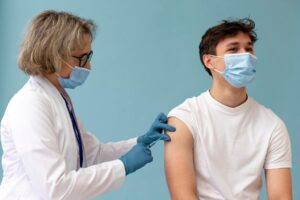Vaccination is one of the most highly effective public health interventions, responsible for saving millions of lives each year. In the US, authorized or approved preventive vaccines must be manufactured with high quality, and the effectiveness and favorable safety profile of vaccines must be demonstrated. Their safety over time is also closely and continuously monitored through multiple overlapping passive and active safety surveillance systems, including the Vaccine Adverse Event Reporting System, the Vaccine Safety Datalink, and the BEST Sentinel Initiative.1
Despite the care taken in the development and deployment of vaccines and their clear and compelling benefit of saving individual lives and improving population health outcomes, an increasing number of people in the US are now declining vaccination for a variety of reasons, ranging from safety concerns to religious beliefs. Setting aside for now the controversial issue of vaccine mandates at the federal, state, or local level in the US, which are not within the purview of the Food and Drug Administration (FDA), the situation has now deteriorated to the point that population immunity against some vaccine-preventable infectious diseases is at risk, and thousands of excess deaths are likely to occur this season due to illnesses amenable to prevention or reduction in severity of illness with vaccines.
To counter the current trend, we urge the clinical and biomedical community to redouble its efforts to provide accurate plain-language information regarding the individual and collective benefits and risks of vaccination. Such information is now needed because vaccines have been so successful in achieving their intended effects that many people no longer see the disturbing morbidity and mortality from infections amenable to vaccines. For example, smallpox has been eradicated, and polio has been eliminated from the US, through effective vaccination campaigns.
Measles was similarly eliminated, but imported cases remain a threat to those who are unvaccinated as well as to those who are immunocompromised. Regrettably, pediatric vaccine hesitancy now has been responsible for several measles outbreaks in the US, including a recent one in central Ohio involving local acquired cases in 85 children, 36 of whom (42%) had to be hospitalized for complications.2 It is sobering to note that vaccine hesitancy to childhood vaccines, such as the measles, mumps, and rubella vaccine, has been found to cluster in middle- to high-income areas among parents with at least a college degree who preferred social media narratives over evidence-based vaccine information delivered by clinicians.3 Anyone doubting the benefits of vaccination need only look to low-income parts of the world where measles vaccination is inaccessible, and many thousands of children continue to die each year due to preventable disease. Unfortunately, with the success of pediatric vaccination campaigns to date, increasing numbers of people have become complacent and underestimate the actual risk of forgoing vaccination.
In addition to making a difference regarding childhood immunization, communication regarding the potential benefits of vaccination can hopefully also improve the number of individuals accepting vaccination to protect against COVID-19, influenza, and respiratory syncytial virus disease. Vaccination rates against these respiratory pathogens are inadequate, and this is most distressing in older individuals in whom the benefits of vaccination in reducing hospitalization and death are eminently clear. In fact, uptake of the updated COVID-19 vaccine (XBB.1.5 monovalent) in the US is only about 35% in those older than 65 years, which is about half the rate in this age group in the UK.
What can we do to start tipping the scales in the direction of evidence-informed vaccine acceptance to reduce the risk of death and illness from diseases in which vaccines are effective? Evidence indicates that the most trusted source of information about health decisions remains clinicians who provide care. Broadly interpreted this also includes retail pharmacists, who may serve as the only source of medical advice for the many individuals in the US who lack a primary care clinician or who are uninsured. All those working in health care, while being straightforward about the risks, need to better educate people regarding the benefits of vaccination, so that individuals can make well-informed choices based on accurate scientific evidence. For example, contrary to a wealth of misinformation available on social media and the internet, data from various studies indicate that since the beginning of the COVID-19 pandemic tens of millions of lives were saved by vaccination (Figure).4 The benefits of these vaccines in prevention were largest in older individuals. However, studies show that people of all ages who are up to date on vaccination benefit and have a lower risk of developing long COVID.5

During the COVID-19 pandemic, vaccine effectiveness appeared to be higher against the original strain of SARS-CoV-2 than against later variants. Nonetheless, since the introduction of the COVID-19 vaccines, in absolute terms vaccination has been associated with notably fewer deaths across the age range. A similar trend was seen in 2021 and 2023, even though the total number of deaths from COVID-19 have decreased more recently (note the order of magnitude difference on the scale). Those up to date on COVID-19 vaccination had notably lower numbers of deaths per million individuals than those who were unvaccinated, and their benefits were apparent across the entire age range early on and more recently following the exposure of a larger number of individuals to natural infection with one of the SARS-CoV-2 variants, with 16.5-fold and 3.6-fold reductions in death, respectively. Figure adapted from an analysis presented on United States: COVID-19 weekly death rate by vaccination status for all ages (ourworldindata.org) using data from the Centers for Disease Control and Prevention (https://bit.ly/41GVqLo).
Read the original article on Jama Network









